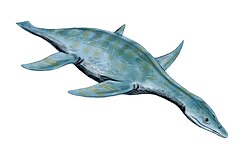Leptocleididae
| Leptocleididae Temporal range: Early Cretaceous,
| |
|---|---|

| |
| Leptocleidus | |
| Scientific classification | |
| Domain: | Eukaryota |
| Kingdom: | Animalia |
| Phylum: | Chordata |
| Class: | Reptilia |
| Superorder: | †Sauropterygia |
| Order: | †Plesiosauria |
| Clade: | †Leptocleidia |
| Family: | †Leptocleididae White, 1940 |
| Genera | |
Leptocleididae is a family of small-sized plesiosaurs that lived during the Early Cretaceous period (early Berriasian to early Albian stage).[1] They had small bodies with small heads and short necks. Leptocleidus and Umoonasaurus had round bodies and triangle-shaped heads. Leptocleidids have been found in what were shallow nearshore, freshwater and brackish habitats.[2] Hilary F. Ketchum and Roger B. J. Benson (2010), transferred Brancasaurus, Kaiwhekea, Nichollssaura and Thililua to this family.[3] However, Ketchum and Benson (2011) reassigned Kaiwhekea and Thililua to their original positions, as an elasmosaurid and a polycotylid, respectively.[1]
Phylogeny
| Leptocleididae |
| ||||||||||||||||||||||||||||||
Cladogram based on Ketchum and Benson (2011):[1]
| Leptocleididae |
| ||||||||||||||||||||||||
References
- ^ a b c Ketchum, Hilary F.; Benson, R. B. J. (2011). "A new pliosaurid (Sauropterygia, Plesiosauria) from the Oxford Clay Formation (Middle Jurassic, Callovian) of England: evidence for a gracile, longirostrine grade of Early-Middle Jurassic pliosaurids". Special Papers in Palaeontology. 86: 109–129.
- S2CID 250964381.
- S2CID 12193439.
